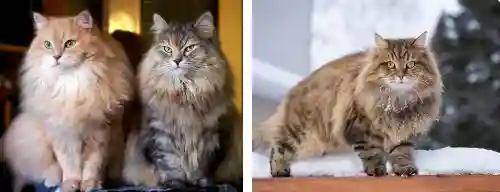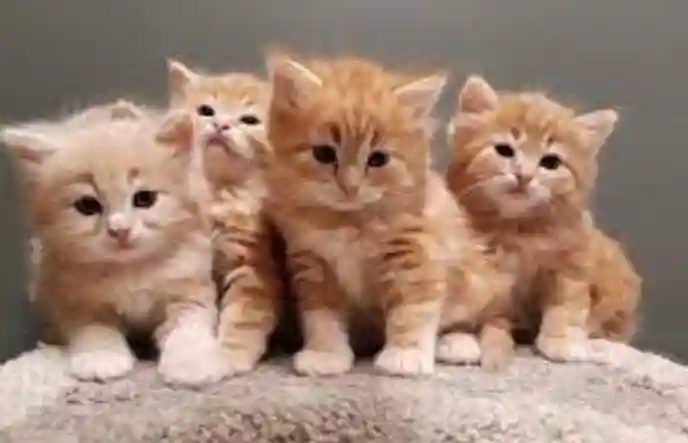Siberian cats are a beautiful breed with unique characteristics. In this article, we will delve into the world of Siberian cats. We will explore their history, physical attributes, personality traits, and care requirements.
Siberian Cat Breed Overview
| Characteristic | Description |
|---|---|
| Weight | 15 to 20 pounds |
| Length | 17 to 25 inches |
| Coat | Moderately long to longhaired triple coat with a full collar ruff, varying from coarse to soft |
| Coat Color | Any color combination or pattern |
| Eye Color | All colors |
| Life Expectancy | 10 to 18 years |
Siberian Cat: Historical Background and Origin
The Siberian cat is a natural breed and Russia’s national cat. These cats have existed for at least a millennium, helping to keep the rodent populations at bay. People considered Siberian Cats to bring good luck, and they often gave them as gifts.
Genetic Characteristics of Siberian Cat
Siberian cats have a triple-layered coat. This serves as protection against the harsh and frigid Siberian climate. They have a well-muscled body, barrel chest, and strong bones. Their eyes range in color from gold to green or even a mix of both. Siberian cats come in a variety of colors and patterns.

Interestingly, Siberian cats also own a unique genetic variation that makes them hypoallergenic. Unlike most cats, Siberians produce less of the Fel d1 protein. This is the primary allergen present in cats.
| Characteristic | Description |
|---|---|
| Origin | Siberia, Russia |
| Size | Medium to large |
| Coat Type | Thick, double-layered fur |
| Coat Colors | Various, including tabby, colorpoint, and solid |
| Hypoallergenic | Considered hypoallergenic due to lower allergen levels |
| Temperament | Playful, energetic, affectionate |
| Lifespan | 12-15 years |
| Dietary Needs | High-quality cat food rich in protein |
| Grooming Requirements | Regular brushing to prevent matting and reduce shedding |
| Health Considerations | Generally healthy, with potential for breed-specific issues |
| Compatibility | Good with children and other pets |
Siberian Cats Evolution Over Time
Over the centuries, Siberian cats have evolved to withstand the extreme cold of the Siberian region in Russia. They have a water-resistant, triple-layered coat. They have large and furry paws that act as snowshoes. They also have tufted ears, and bushy tails to protect against cold. But, their exact genetic evolution remains a mystery. There hasn’t been much scientific study around it.
Recent years have seen a rising interest in the breed outside Russia. This demand leads to a gradual change in breeding practices to meet new standards. This has led to the development of more robust cats with larger bodies and broader heads.
Siberian Cats Myth
These enchanting cats hold a special place in Russian mythology. They were often seen as protectors of households, keeping evil spirits at bay. People considered Siberian Cats to bring good luck, and they often gave them as gifts.
What Makes Siberian Cats So Adorable?

Siberian cats are adored by feline enthusiasts for lots of reasons. One of the top attractions of these cats is that they are hypoallergenic. This makes them a viable pet option for those who are usually allergic to cats. Their appeal is their playful, affectionate, and intelligent nature. Siberian cats are excellent jumpers and climbers.
Another standout quality of Siberians is their loyalty. They get along well with other pets and children in the household. Being adaptable, they thrive in various environments and are low-maintenance.
Health Concerns of Siberian Cats
Siberian cats are generally known for their good health and robustness. But, they can be prone to certain breed-specific health issues. One of the most prevalent among these is Hypertrophic Cardiomyopathy (HCM). HCM is a form of heart disease that results in the thickening of the heart’s muscle tissue. It can lead to congestive heart failure if not diagnosed and treated in its early stages.
Another genetic disease that can affect Siberian cats is Polycystic Kidney Disease (PKD). PKD is a condition where many cysts form in the kidneys, which could lead to kidney failure. Regular ultrasounds can identify these cysts in cats at risk.
Siberian cats can also suffer from obesity due to their affection for food. Obesity can lead to other serious health conditions such as diabetes, heart disease, and arthritis. Hence, regulating their diet and exercise is crucial in maintaining their health.
Exercise Needs of Siberian Cats
Siberians are energetic and active cats. They need regular playtime and physical stimulation for wellness and to curb obesity. Interactive toys, puzzle games, and cat trees are perfect tools to keep Siberians engaged. At least 15-30 minutes of active play per day is beneficial for these athletic cats.
Grooming for Siberian Cats

Siberian cats have luxurious triple-coated fur that requires regular grooming. Brush their coat at least twice a week with a slicker brush or a steel comb to prevent matting and reduce shedding. Daily grooming may be necessary during spring and autumn. When they shed their undercoat to prevent hairballs.
Bathing may be necessary, depending on the cat’s lifestyle and cleanliness. Weekly teeth brushing is essential to prevent dental diseases. Additionally, it is recommended to inspect and clean the ears. Also, trim the nails for optimal health.
Preventive Measures for Maintaining Siberian Cat’s Health
Taking care of your Siberian cat’s health is important. Regular vet check-ups are crucial to catch and manage health problems early. These check-ups include screenings for HCM and PKD, vaccinations, and deworming.
To keep your Siberian cat at a healthy weight, provide a balanced diet and opportunities for play with toys that encourage movement.
Regular grooming also helps. While Siberian cats are low-maintenance due to their oily coat. Brushing helps remove loose hair and prevent hairballs.
Siberian cats have lower levels of the Fel-d1 protein in their saliva. This can reduce allergies in some people. Individual reactions vary, so spend time with a Siberian cat before bringing one home if allergies are a concern.
Genetic diversity is important for their health. Inbreeding can lead to inherited diseases like HCM and PKD. Breeders should focus on maintaining genetic diversity to ensure the health and longevity of the Siberian cat breed.
10 Interesting Facts about Siberian cats
- Siberian cats are hypoallergenic: They produce low levels of the allergen Fel d 1, making them more suitable for allergy sufferers.
- Natural waterproof coat: Their triple-layered coat repels water, helping Siberian cats stay dry even in wet conditions.
- Excellent jumpers: Siberian cats are agile and skilled at reaching high places.
- Strong hunting instinct: These cats enjoy hunting and chasing prey, both indoors and outdoors.
- Intelligent and curious: Siberian cats love exploring, solving puzzles, and playing with interactive toys.
- Dog-like temperament: Siberians are friendly and loyal, displaying characteristics more commonly associated with dogs.
- Ancient breed: Originating in Russia centuries ago, Siberian cats are one of the oldest cat breeds.
- Skilled swimmers: Their waterproof coat also enables them to enjoy playing in water.
- Adaptable to different climates: Siberian cats can thrive in both cold and warm environments.
- Need regular grooming: Despite being low maintenance, they require regular brushing to prevent matting and maintain their fur.
Is a Siberian Cat Right for You? Pros and Cons to Consider
| Advantages | Disadvantages |
|---|---|
| Hypoallergenic qualities for allergy sufferers | Regular grooming needs due to their long, dense fur |
| Friendly and sociable, forming strong bonds | Strong hunting instincts may lead to occasional hunting of smaller pets |
| Playful and active, making them great companions | Potential for shedding, especially during seasonal changes |
| Intelligent and curious, enjoy interactive play | May have territorial tendencies, needing personal space |
| Dog-like loyalty and affection | Require regular vet check-ups for potential health issues |
Thinking of Adopting a Siberian Cat?
| Adoption Platforms |
|---|
| Adopt a Pet |
| Petfinder Near You |
| Siberian Rescue – Rescue Me |
Conclusion
Siberian cats are a beautiful breed with a stunning appearance and charming personality. Siberian cats make for wonderful companions. Their unique characteristics and hypoallergenic qualities set them apart in the world of cat breeds.
Frequently Asked Questions (FAQs)
Are Siberian cats good with children?
Yes, Siberian cats are generally good with children. They are playful and patient, making them suitable for families.
Do Siberian cats require a lot of grooming?
Siberian cats need regular grooming to maintain their coat. But it’s manageable with routine brushing.
Are Siberian cats prone to health issues?
Siberian cats are generally healthy cats. But like all breeds, they can be susceptible to certain health conditions. Regular veterinary check-ups are essential.
How big do Siberian cats get?
Siberian cats are a medium to large breed, with males typically larger than females. They can weigh between 10 to 20 pounds.
Can Siberian cats adapt to apartment living?
While Siberian cats enjoy space to roam. They can adapt to apartment living if provided with enough play and exercise opportunities.
Further References
References & Sources
- About the Siberian: The Cat Fanciers’ Association
- Pet Allergy: Are You Allergic to Dogs or Cats? Asthma and Allergy Foundation of America
- Siberian Breed: The International Cat Association







Leave a Comment
You must be logged in to post a comment.